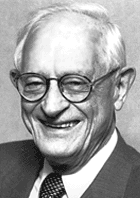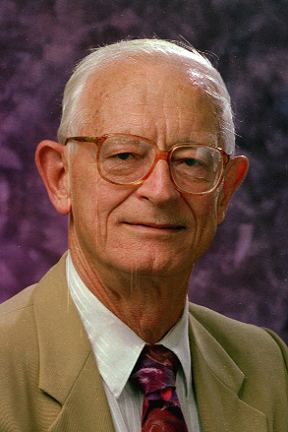Name Alan MacDiarmid | Role Chemist | |
 | ||
Nationality New Zealand, United States Institutions University of PennsylvaniaUniversity of St AndrewsUniversity of Texas at Dallas Alma mater Victoria University of Wellington (BSc)University of Wisconsin–Madison (MSc)University of Cambridge (PhD) Similar People Alan J Heeger, Hideki Shirakawa, Paul Callaghan, Maurice Wilkins | ||
Alan MacDiarmid | Wikipedia audio article
Alan Graham MacDiarmid, ONZ FRS (14 April 1927 – 7 February 2007) was a New Zealand-born American chemist, and one of three recipients of the Nobel Prize for Chemistry in 2000.
Contents
- Alan MacDiarmid Wikipedia audio article
- Portrait of Alan MacDiarmid 2001 by his cousin Douglas MacDiarmid
- Early life and education
- Career and research
- Conductive polymers
- Awards and honours
- Personal life
- References

Portrait of Alan MacDiarmid (2001) by his cousin Douglas MacDiarmid
Early life and education
MacDiarmid was born in Masterton, New Zealand as one of five children – three brothers and two sisters. His family was relatively poor, and the Great Depression made life difficult in Masterton, due to which his family shifted to Lower Hutt, a few miles from Wellington, New Zealand. At around age ten, he developed an interest in chemistry from one of his father's old textbooks, and he taught himself from this book and from library books.
MacDiarmid was educated at Hutt Valley High School and Victoria University of Wellington.
In 1943, MacDiarmid passed the University of New Zealand's University Entrance Exam and its Medical Preliminary Exam. He then took up a part-time job as a "lab boy" or janitor in Victoria University of Wellington, during his studies for a BSc degree, which he completed in 1947. He was then appointed demonstrator in the undergraduate laboratories. After completing an MSc in chemistry from the same university, he later worked as an assistant in its chemistry department. It was here that he had his first publication in 1949, in the scientific journal Nature. He graduated in 1951 with first class honours, and won a Fulbright Fellowship to the University of Wisconsin–Madison. He majored in inorganic chemistry, receiving his M.S. degree in 1952 and his PhD in 1953. He then won a Shell Graduate Scholarship, which enabled him to go to Sidney Sussex College, Cambridge, where he completed a second PhD in 1955.
Career and research
MacDiarmid worked in the School of Chemistry at the University of St Andrews in Scotland for a year as a member of the junior faculty. He then took a faculty position in chemistry at the University of Pennsylvania, USA, where he became a full professor in 1964. MacDiarmid spent the greater part of his career on the chemistry faculty of the University of Pennsylvania, where he worked for 45 years. The first twenty years of his research there focused on silicon chemistry. He was appointed Blanchard Professor of Chemistry in 1988.
In 2002 MacDiarmid also joined the faculty of the University of Texas at Dallas.
Conductive polymers
His best-known research was the discovery and development of conductive polymers—plastic materials that conduct electricity. He collaborated with the Japanese chemist Hideki Shirakawa and the American physicist Alan Heeger in this research and published the first results in 1977. The three of them shared the 2000 Nobel Prize in Chemistry for this work.
The Nobel Prize was awarded for the discovery that plastics can, after certain modifications, be made electrically conductive. The work progressed to yield important practical applications. Conductive plastics can be used for anti-static substances for photographic film and 'smart' windows that can exclude sunlight. Semi-conductive polymers have been applied in light-emitting diodes, solar cells and displays in mobile telephones. Future developments in molecular electronics are predicted to dramatically increase the speed while reducing the size of computers.
MacDiarmid also travelled around the world for speaking engagements that impressed upon listeners the value of globalising the effort of innovation in the 21st century. In one of his last courses, in 2001, MacDiarmid elected to lead a small seminar of incoming freshmen about his research activities. Overall, his name is on over 600 published papers and 20 patents. MacDiarmid was also active as a naturist and nudist, and considered himself a sun-worshipper and keen waterskier.
Awards and honours
MacDiarmid won numerous awards and honours including:
Personal life
Towards the end of his life, MacDiarmid was ill with myelodysplastic syndrome. In early February 2007 he was planning to travel back to New Zealand, when he fell down the stairs in his home in Drexel Hill, Pennsylvania, a suburb of Philadelphia, and died on 7 February 2007. He is buried at Arlington Cemetery in Drexel Hill.
MacDiarmid's first wife, Marian Mathieu, who he had married in 1954, died in 1990. He is survived by four children: Heather McConnell, Dawn Hazelett, Duncan MacDiarmid and Gail Williams, from their marriage and nine grandchildren: Dr. Sean McConnell, Dr. Ryan McConnell, Rebecca McConnell, Dr. Clayton Hazelett, Wesley Hazelett, Langston MacDiarmid, Aubree Williams, Austin Williams and George Williams. MacDiarmid was also survived by his second wife, Gayl Gentile, whom he married in 2005; she died in 2014.
